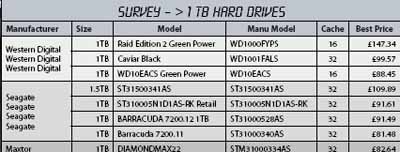articles/Computers/bigcomputer-page5
Big Computer 3 is one year old! - part 5 of 1 2 3 4 5 6
by Mike McNamee Published 01/06/2009

There is a decrease in write speed due to calculations that have to be made before data is written to the drives. If you want to increase read/write speed and have the benefits of RAID 5, you need to implement RAID 10. With 3 drives, there is a 33% loss of disk space. With 5 drives, there is a 20% loss of disk space. You will need the additional drives and a RAID controller which increases cost.
'Package' feature of InDesign is used to create a new folder 'Pi_JunJul09_CfO' and this is backed up into the system (CfO stands for Collect for Output, a throwback to our Quark days). This also reduces the total size by about 75% and this allows DVDs to be made as well. It does not, however, contain any unused images, diagrams or calculations we may have employed.
7. PDF files are made ready and transmitted to the printing company via ftp. Copies of the completed pdf files are made to DVD, transmitted electronically to the Head Office along with lowresolution versions for the website.
8. As soon as the magazine proofs have been approved and we have 'gone to press' without any issues we do some housekeeping, shuffle the oldest magazine file-set off the C drive of the work station, and create a new folder for the next issue. Backups are finalised to two hard drives and these presently stretch back to 2004

Although this is not a totally secure protocol it is strong enough to ensure that we reach the member's door-mats on time and have all files available for reference and re-use of some design material. The methodology could equally apply to weddings or important shoots.
Storage Options
Fundamental to more reliable systems is the use of RAID (Redundant Array of Inexpensive Discs). Depending upon how the RAID array is arranged you achieve improved data-throughput speed, more reliability or both. With the best systems they can withstand failure of a drive without any interruption of the service, some can withstand two, simultaneous drive failures.
Such a system was built recently for another organisation. Eighteen 1TB drives were purchased and stress-tested prior to installation, to seek out any weaklings the so-called infant mortality), one failed. The accepted drives were built into RAID arrays in two discrete server housings accommodated at two secure hosting sites. Access to the server rooms at these sites is very restricted, needing facial recognition, fingerprint recognition, a password and an appointment - just to get to reception. The building is devoid of windows and armoured against attack by ram-raiders (the motor vehicle type not random access memory!). This is what you call a secure hosting site!
As part of the definition of the system requirements all options were considered including off-the-shelf solutions, the Drobo and other proprietary storage devices. Options, included: Drobo, Netgear ReadyNAS Pro, Thecus NAS devices, a Dell server optimised for storage, an HP StorageWorks, a Sun storage server and a few others The costs of these ranged from £500-£1,500, without disks, for the appliances, and from around £4,000 (discounted) for a full-blown server. The Drobo would cost around £740 with four 1TB drives. However, we are hearing too many issues on reliability and would not commit to this solution at present. There are also particular issues reported when Drobo is used with 64-bit Vista (tell us something that surprises us, please!)
Please Note:
There is more than one page for this Article.
You are currently on page 5
- Big Computer 3 is one year old! page 1
- Big Computer 3 is one year old! page 2
- Big Computer 3 is one year old! page 3
- Big Computer 3 is one year old! page 4
- Big Computer 3 is one year old! page 5
- Big Computer 3 is one year old! page 6
1st Published 01/06/2009
last update 21/07/2022 08:46:23
More Computers Articles
There are 6 days to get ready for The Society of Photographers Convention and Trade Show at The Novotel London West, Hammersmith ...
which starts on Wednesday 14th January 2026










